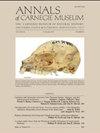Carnegie Institute Extension Connemara Marble: Cross-Atlantic Connections between Western Ireland and Gilded Age Architecture in Pittsburgh, Pennsylvania
IF 0.9
4区 地球科学
Q4 PALEONTOLOGY
引用次数: 0
Abstract
The Connemara Marble of Ireland is a distinctive green decorative stone used in world architecture. These stones were imported and widely used in the Carnegie Institute Extension built in 1907 which is acknowledged as one of the America's finest Gilded Age Beaux-Arts structures. This report documents the use, quantities, and locations of Connemara Marble in the Carnegie Institute and through a review of historic primary source documents, secondary sources articles, on-site inspections, sampling, testing, and microscopic analysis has determined the stone's mineralogy and petrology, color types, and the specific location and identify of the actual quarry site and the lithostratigraphy from which these materials originated. In the 1970's the Carnegie Institute was listed in the National Register of Historic Places by the United States Department of the Interior and named a Historic Landmark by the Pittsburgh History Landmarks Foundation. In 2019, the Connemara Marble was proposed as a Global Heritage Stone Resource to the International Union of Geological Sciences. The Carnegie Institute incorporates 32 varieties of igneous, metamorphic, and sedimentary rocks types from Algeria, Croatia, France, Greece, Italy, Ireland (i.e., the Connemara Marble), and the United States of America. The building's architects utilized four-color types of Connemara Marble in 13 prominent interior spaces of the building. The Connemara Marble formed from Precambrian Dalradian carbonates during the lower Ordovician Grampian orogeny, some 470 million years ago in western Ireland. Approximately, 366 square meters of floor tiles and wall inlays were fabricated out of some 60 metric tons of Connemara Marble blocks extracted from the Streamstown quarry near Clifden, County Galway.卡耐基研究所扩展康涅马拉大理石:横跨大西洋的西爱尔兰和宾夕法尼亚州匹兹堡的镀金时代建筑之间的联系
爱尔兰的康涅马拉大理石是一种独特的绿色装饰石,用于世界建筑。这些石头是进口的,并广泛用于1907年建造的卡内基学院扩建工程,该扩建工程被公认为美国镀金时代最精美的美术建筑之一。本报告记录了卡耐基研究所康涅马拉大理石的用途、数量和位置,并通过对历史第一手资料、二手资料文章、现场检查、抽样、测试和显微分析的回顾,确定了石头的矿物学和岩石学、颜色类型、实际采石场的具体位置和识别,以及这些材料起源的岩石地层。20世纪70年代,卡内基学院被美国内政部列入国家史迹名录,并被匹兹堡历史地标基金会命名为历史地标。2019年,康涅马拉大理石被国际地质科学联盟提议为全球遗产石材资源。卡内基研究所收藏了来自阿尔及利亚、克罗地亚、法国、希腊、意大利、爱尔兰(即康涅马拉大理石)和美国的32种火成岩、变质岩和沉积岩。该建筑的建筑师在建筑的13个突出的内部空间中使用了四色康涅马拉大理石。Connemara大理岩形成于约4.7亿年前的爱尔兰西部,形成于下奥陶纪格兰平原造山运动时期的前寒武纪达拉德纪碳酸盐岩。大约366平方米的地砖和墙壁镶嵌是由从高威郡克利夫登附近的Streamstown采石场开采的约60公吨Connemara大理石块制成的。
本文章由计算机程序翻译,如有差异,请以英文原文为准。
求助全文
约1分钟内获得全文
求助全文
来源期刊

Annals of Carnegie Museum
综合性期刊-动物学
CiteScore
2.50
自引率
18.20%
发文量
4
审稿时长
>12 weeks
期刊介绍:
Annals of Carnegie Museum is a quarterly journal that publishes peer-reviewed short and medium-length original scientific contributions in organismal biology, earth sciences, and anthropology, in 40 by 52.5 pica format (168 by 220 mm or 6-5/8 by 8-5/8 inches). Subject matter must be relevant to Carnegie Museum of Natural History scientific sections or Powdermill Nature Reserve (PNR), preferably with connection to the Carnegie collection and/or personnel. Carnegie Museum staff and research associates receive publication priority, but others are encouraged to submit papers, especially those manuscripts explicitly based on the Carnegie collection.
 求助内容:
求助内容: 应助结果提醒方式:
应助结果提醒方式:


